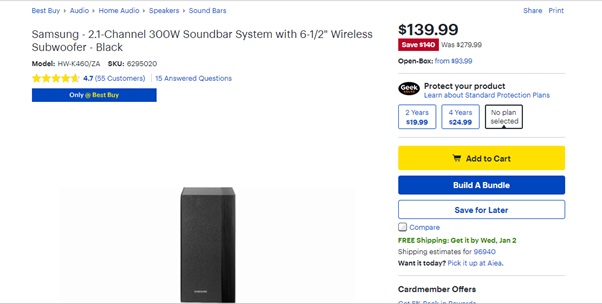
History always has some lessons to teach and often the past stories dictate and shape the future ones. In terms of business and commerce, this comes in the form of annual reports, surveys and useful data which carries some essential takeaways for companies’ approach to change with the customers’ attitude and response.
Today we’ll be analysing the findings and reports of the recent Black Friday including statistics on both sides of the occasion: business and consumers, and what’s the relevance of these numbers for the future iterations of the popular hyper-discount bonanza.
TAKEAWAY #1- Users are more eager than ever
The numbers speak for themselves: Racking up $6.22 billion in the US alone, this year’s Black Friday has seen an astounding 23.6 percent rise in revenue generated compared to previous year. Furthermore, the average order values for electronics and furniture, also saw an increment of 8.5% compared to last year, totalling 146$.
By Saturday morning, $400 million had been spent on deals which saw a 24% rise from Black Friday 2017. This report was brought forth by Adobe Analytics, formerly known as Omniture, which plays an important role in the business sector by helping companies figure out and work with important metrics in the marketing department.
Amazon UK reached a new milestone this Black Friday with over 100,000 toys and 60,000 beauty items purchased on the big day. Overall conversion rates for Black Friday 2018 marked the record highest of the year, around 4.9%.
The cash doesn’t stop rolling in for the businesses as Adobe Analytics forecasts that 48% of consumers based in France will spend substantial amounts as we reach the end of the weekend.
All of these crazy high metrics of success show that users are more engaged than ever and will continue to look forward to discounted deals and special limited time offers. This trend has been true for the last year as well with both residents of UK and Germany who shopped for Black Friday in 2017, rose up to 20% compared to individuals who shopped on Black Friday 2016.
US and Canada have also grown in terms of consumers spending more on the occasion in 2017 compared to the year before, but it’s been marginal with 1% in the US and 9% in Canada.
Of all these respondents, over 50% purchased products primarily from online retailers. Thus it’s no doubt that all businesses, especially e-commerce platforms, are bound to see a rise in their sales on future Black Friday occasions thanks to this awareness among the audience.
It’s needless to say the source for this attraction has been and will be mouth-watering deals like this one at BestBuy that offers $140 dollars off.

On average, the discount rates via the digital medium of commerce stood at a decent 27%. Of course, we’ve got examples on this Black Friday where absence of such hyper-discounts led from little to no awareness about a particular brand at all.
Sears has already had a rough year with sales decline and no later than Oct 15, the company declared brankruptancy. This, understandably so, had an impact on their Black Friday campaign with almost inexistent deals as complained by the handful of customers that did make their way to the store.
Thus it’s clear the growing awareness and eagerness for individuals to shop during Black Friday will continue to grow as long as they are given a reason to save up on money via trendy and discounted deals.
TAKEAWAY# 2- The growing importance of omnichannel and mobile devices
In regards to all the sales discussed above, 33.5% of the revenue generated came directly from handheld device channels amounting to almost over $2 billion. This marks 4.4% increase to that of the sales brought in by mobile devices in 2017. In terms of conversion rates, there was an increase of 10% among the mobile users compared to the previous year.
The survey before Black Friday 2018 also foreshadowed the success of mobile channels as 25-30% of the potential consumers across US, UK, Germany and Canada showed interest in securing purchases via mobile browsers. There’s also the matter of virtual assistants with the likes of Alexa and Siri that accounts for 8% of potential deals secured in the US according to the survey.
It’s no surprise that these metrics have been favourable to mobile channels thanks to their accessibility, ease-of-use and the portable nature. All e-commerce platforms should, therefore, work towards optimizing their mobile website to make the experience as smooth and consistent as possible.
These changes range from improving mobile page load times to creating a smoothly transitioning navigation system, so basically everything that will make it convenient for users and for your business, well you will be able to capitalize on these big numbers.
The metrics associate closely with Omni channel platforms as well like that of Amazon, Kohl’s and Walmart with their ‘click-and-collect’ services that ensures the product is delivered as quickly to the costumer, lest to not create any inconveniences.
This approach reflects in the statistics as well since such services created high demand for orders which rose up 73% from Thanksgiving to Black Friday.

Of course the omnichannel strategy does not stop here as much effort was made to communicate alerts and updates regarding deals and purchases via push notifications, emails and social media.
About 106 million SMS & push notifications were sent out compared to the previous year’s output of 82 million. While in the email department, consumers received 3.5 billion updates in their inboxes which is a 0.5 billion increase from last year.
Lastly, social media brought 5.7% of all traffic to the online retailers, 94% of which is owed to platforms like Facebook and Instagram alone.
This tells us how far ecommerce platforms have come to ensure that just a desktop version of the website won’t suffice in the competitive landscape. Instead, businesses should utilize every opportunity to provide the best user experience be it via mobile apps, social media or other channels.
TAKEAWAY #3- Discount season starts early
A rising trend that seems to have become popular recently is that discounted deals start becoming available even before the official arrival of Black Friday.
This year, electronics and video game retailer, GameStop started its online Black Friday campaign in the latter part of 21st November while Walmart also began the sale on the same day. Macy’s and Best Buy revealed their deals the subsequent day on 22nd November.
These big names when it comes to electronics and fashion all started before Black Friday to create more hype and tease viewers to get them on board with the whole campaign.
You shouldn’t ignore the obvious consequence of such a decision either, which will allow users to spend more time in choosing which product to buy and making plans accordingly. In such a way, the pre-Black Friday deals will give viewers and visitors a glimpse into what awaits them when the actual occasion arises.
As a survey shows, users start their research and planning on shopping online before November. So we’ve got a question for you, if the consumers start early, why shouldn’t you?
CONCLUSION
Occasions like Thanksgiving, Black Friday and Christmas season are of quite some value to business owners and online retailers not only because of the monetary profits that they seem to bring, but the insights and lesson that they carry with them.
This Black Friday was no different which demonstrated the emphasis on utilizing multiple channels for sales, customizing your target audience for ad sets, starting earlier than usual and knowing your audience and what they want in terms of discounted deals on an occasion that puts both the interested parties ‘in the black’ in their own terms and senses.